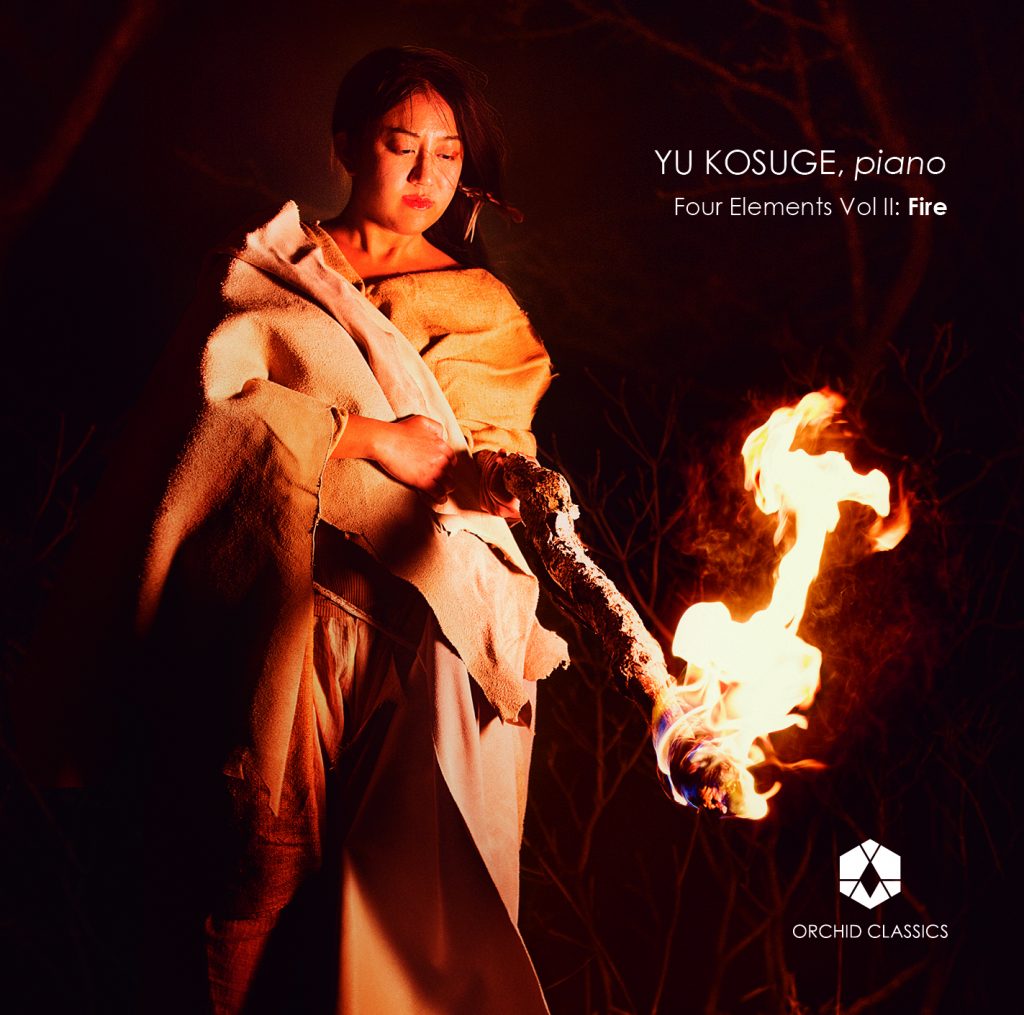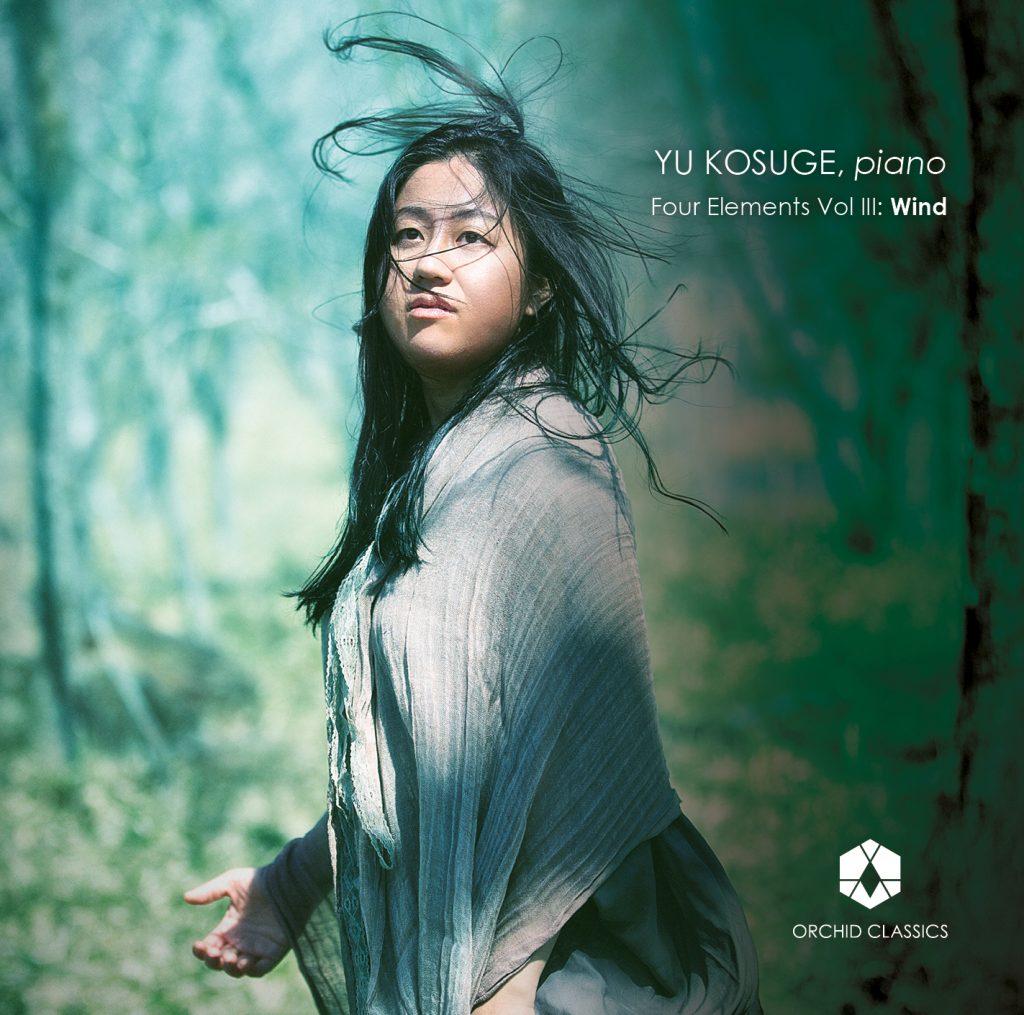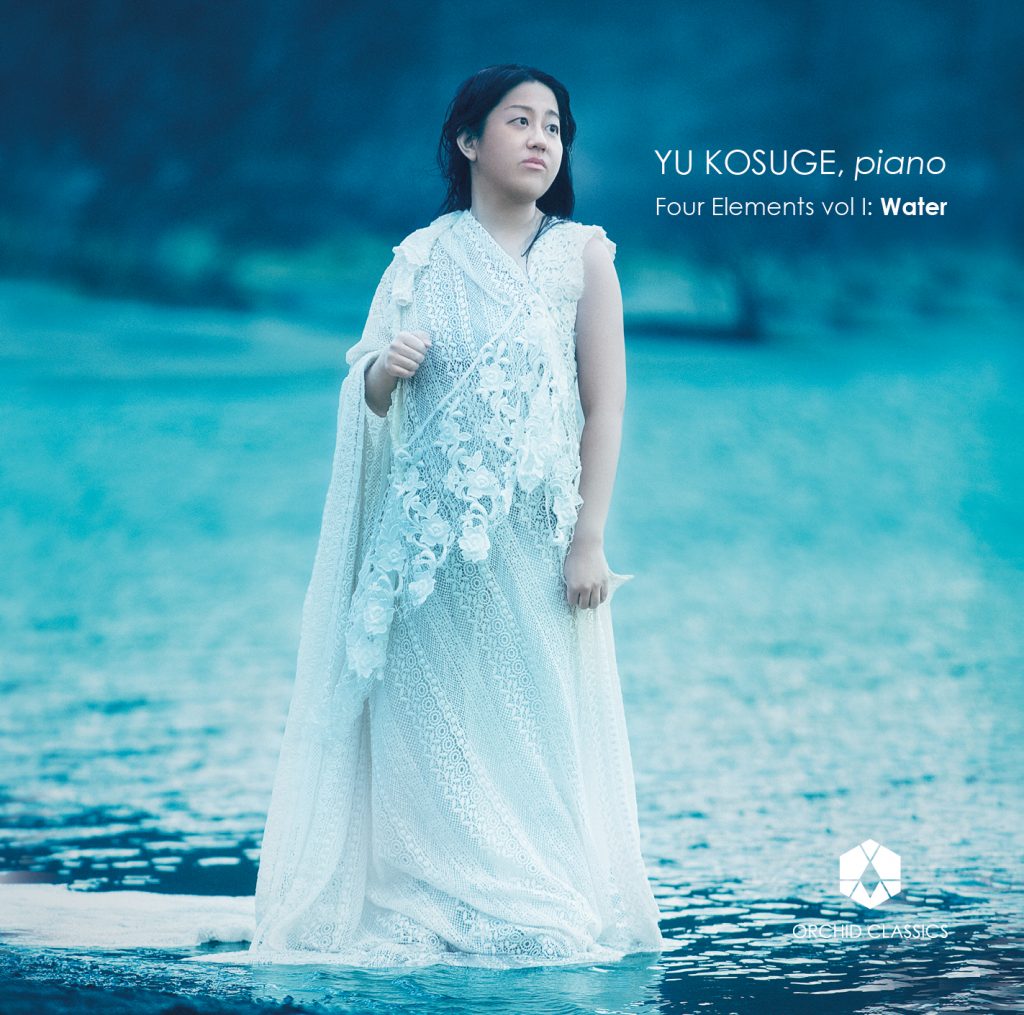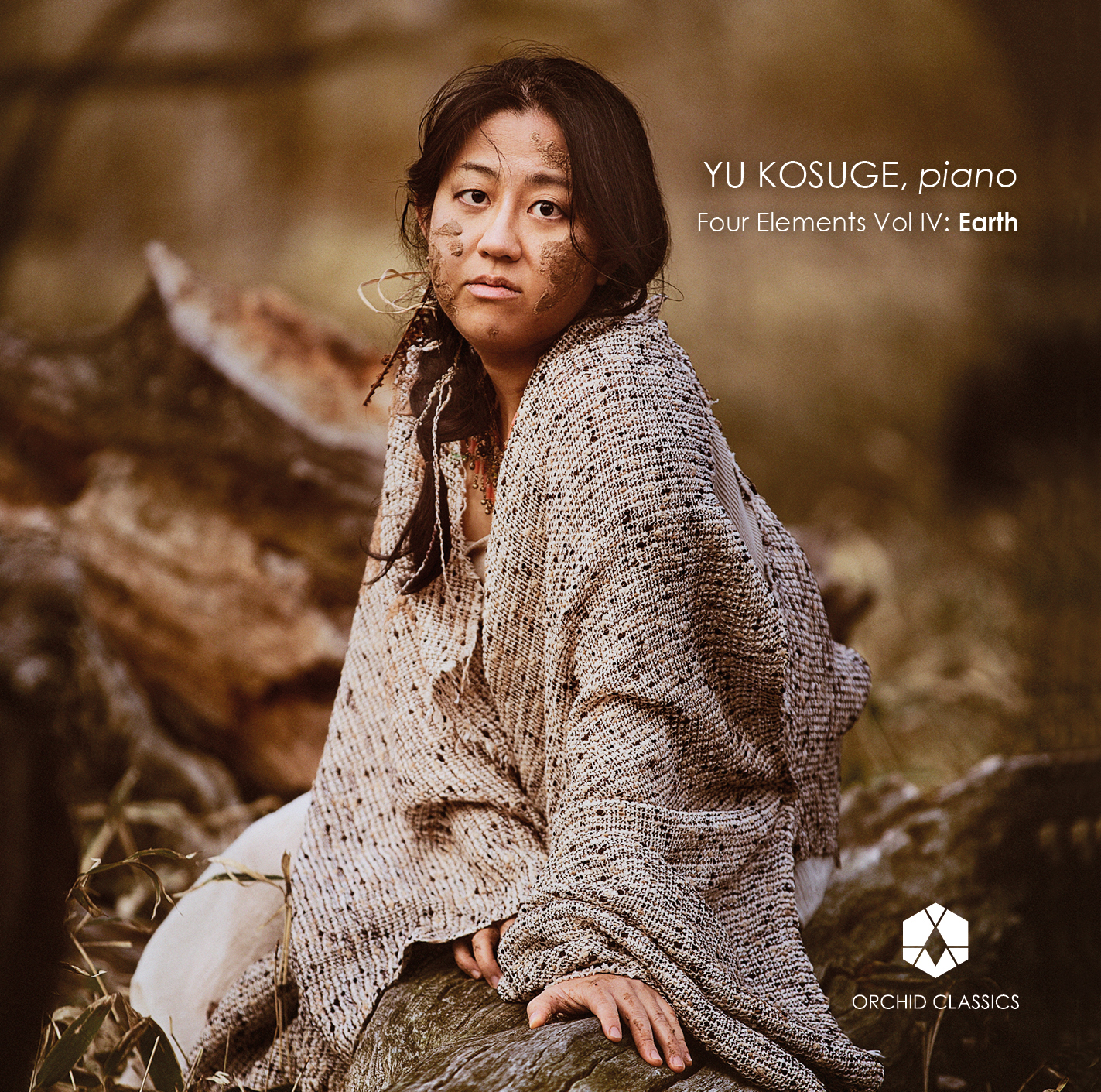Japanese pianist Yu Kosuge concludes her series of Orchid Classics albums related to the four elements with the final release of the set: Earth. Kosuge was inspired to create this series by the music of Beethoven, who was fascinated by Greek legends, prompting her to explore the Greek concept of the four elements in these albums.



Four Elements: Earth
Franz Schubert (1797-1828)
Fantasy in C major “Wanderer-Fantasie”, D.760
1. Allegro con fuoco ma non troppo
2. Adagio
3. Presto
4. Allegro
Leoš Janáček (1854-1928)
Sonata 1. X. 1905
5. “Předtucha” (The Presentiment)
6. “Smrt” (The Death)
Dai Fujikura (b.1977)
7. Akiko’s Diary
Frédéric Chopin (1810-1849)
Piano Sonata No.3 in B minor, Op.58
8. Allegro Maestoso
9. cherzo. Molto Vivace
10. Largo
11. Finale. Presto ma tanto
Yu Kosuge, piano
My ‘Four Elements’ project now comes to an end with the theme of “Earth”.
Water, Fire and Wind are all elements necessary to a human being, but with Earth we get close to the human being itself, and our own struggles in life.
We are born from earth, and through the unconditional love of our parents we each grow up in our own, individual way. The environment of a human being is shaped by the language, nature and even the music which surrounds us, and we can change through our experiences.
On this final disc, we wander through the most beautiful nature while questioning our life and our identity in solitude. At the end of our lives, we die and go back to earth. But death can be caused unnaturally. We arrive at two pieces dedicated to the loss of innocent young lives due to the cruel monstrosity of humans. In the end, earth can be a place where we feel safe and loved, with the nostalgia and longing for home something we all feel in our lives.
___________________
Between composers like Haydn, Mozart and Beethoven who had their major careers in Vienna, Franz Schubert (1797-1828) was the only one who was also born in Vienna. After the French Revolution the era of patrons ended, and Schubert built his career inside the Biedermeier’s domestic culture. At that time, Beethoven and also Schubert were suffering from the repressive politics of the foreign minister of Austrian Empire, Clemens von Metternich, who was the chief architect of the Vienna Treaty of 1815 after the French Revolution and Napoleon War.
Die Sonne dünkt mich hier so kalt,
Die Blüte welk, das Leben alt,
Und was sie reden, leerer Schall;
Ich bin ein Fremdling überall.
The sun here seems to me so cold,
wilted the bloom, and life here – old.
And what they talk is but hot air –
I am a stranger everywhere.
From Der Wanderer D.489 (D.493), poem by Georg Philipp Schmidt von Lübeck
(translation from https://lyricstranslate.com/de/der-wanderer-wanderer.html)
Schubert had an unhappy life, but the years 1822-23 were especially distressful for him. While his creativity on the Lied-repertoire grew steadily, lots of attempts on instrumental and symphonic work stayed unfinished. His most loyal friends were scattered in cities far away and from 1822 autumn he was also suffering from symptoms of syphilis and was hospitalized for a long time in 1823.
The Fantasy in C major “Wanderer-Fantasie”, D.760 is a result of all such efforts of study and conflicts.
While its form is constructed like a symphony (Allegro-Adagio-Scherzo-Finale), these four movements without pause can also be understood as the classical sonata form Exposition-Development-Reprise-Coda. The rhythmic motif of his own song Der Wanderer D.489 (D.493) from 1816 leads through the whole piece, and all the movements are woven together as one drama.
It begins lively in a repeating dactylic rhythm in Allegro. The heroic character and orchestral sound suggests as if wandering in the mountains. The rhythm then turns to a lyrical second theme. After the stern and intense beginning of the development section, an elegant, new theme appears before it develops to a climax. Then only the motif remains in simple form and leads to the key of the next movement. In the Adagio in c-sharp minor the motif of the middle section of the song is used (see the poem above) as the theme but it progresses with a E-major variant. This movement is full of suffering and loneliness, as if wandering in the coldness, which forebodes the mood of his late song-cycle “Winterreise”. When it changes to the major key the beauty suggests Schubert’s typical utopia of peacefulness and happiness which cannot be realised in real life but only in heaven. The pain and beauty are ambivalent throughout the movement. In the Scherzo the motif of the Wanderer changes to a Waltz in A-flat major, and the Viennese elegant dance gradually turns into a storm to reach the finale. The initial heroic march rhythm which feels ironic this time around turns into a fugue, which develops to a climax as if climbing and overcoming one conflict after another.
From the motif of Wanderer I feel the searching and longing for freedom. He may have put the message of freedom he yearned for, and his lifelong loneliness, into the figure of the Wanderer?
In the second half of the 19th century social issues were also a lifelong problem for another composer. Leos Janáček (1854-1928) was born in Brno in Moravia which was under Austrian rule at that time. German was a common language in Brno then and Janáček also went to a German school. But the Czechs gradually fought for independence and Czech language schools or cultural centers were built. With the movement for independence the conflict with the Germans grew and came to a head at the beginning of the 20th century. When Czech parliamentary members appealed to the Austrian government to build the second Czech university in Moravia, in Brno, the Germans refused in fear of emancipation of the Czechs. On the 1st October 1905 the Germans demonstrated in front of Brno’s German House, while the Czechs formed anti-German demonstration at which Janáček also participated, outside the Besedni dum, a multi-purpose center and workplace of Janáček. Between these demonstrations violence ensued and when the military intervened against the Czech demonstration a 20-years old labourer, Frantisek Pavlik, was stabbed outside the entrance of Besedni. Enraged by this incident, Janáček wrote Piano Sonata 1. X. 1905.
Janáček wrote as a supplement to the first edition:
“The white marble of the steps of the Besedni dum in Brno. The ordinary labourer Frantisek Pavlik falls, stained with blood. He came merely to champion higher learning and has been slain by cruel murderers“ (from the Preface of Baerenreiter edition).
This sonata consisted initially of 3 movements, but the manuscript of the 3rd movement was burned and the first two thrown into the Vltava river by Janáček. However, a copy of the first two movements survived.
The first movement, “Předtucha” (The Presentiment) begins with a folksong-like melody as if spoken suddenly, which is accompanied by rhythmic figures in cymbalon character throughout the piece. When the melody filled with agony and sadness climaxes, it relaxes into a nostalgic expression. The development section ends in an outburst of emotions before the theme reprises. The nostalgic motif reprises in A-flat major even dreamier, before it grows to the final lament and ends softly.
The second movement “Smrt” (The Death) begins with a theme and motif of which a pause always precedes repeats, as if like a wistful mutter. Then the next theme begins anew while keeping this rhythm, as if looking back to the past and recounting what happened, while a punctured rhythmic motif answers in the left hand. This motif gradually develops to a continuous pattern which brings out a sense of urgency which climaxes violently. The first theme returns this time in fortissimo, in a rage, with an always urging answer in the left hand. The dialogue gradually softens as if disappearing into another world.
Death is something we can’t avoid and the image to go back to earth should be natural. But the death of innocent young lives caused by cruel doing of humans feels just like ruthless sins.
Dai Fujikura (b.1977)’s “Akiko’s Diary” originated as the cadenza part of the Piano Concerto No.4 “Akiko’s Piano” (2019), which was made into an independent piece for solo piano by the composer. It was written in 2020 for the Music for Peace Concert of the Hiroshima Symphony Orchestra, for the 75th year since end of World War II and nuclear attack.
The pianist is supposed to move to a specific piano only for this cadenza. This piano belonged to a girl named Akiko Kawamoto who died from the repercussions of the radiation caused by the atomic bomb in Hiroshima, when she was 19.
Akiko was born in Los Angeles, USA and moved to Hiroshima when she was 6 years old. She enjoyed playing the piano and her lessons. On the 6th August 1945, when she was working as a mobilized student, the atomic bomb dropped. She wasn’t injured directly but swam the river to go back to her parents as the bridge had been destroyed. She died in the arms of her parents the next day from the radiation.
The piano which still has glass splinters of the window from the blast stuck on the side came into the hands of a piano technician in 2002, who took great care of it. It was restored, but the personality of the instrument stayed. A group of wonderful people made the story of Akiko public with the message of peace in mind.
Dai spent days to compose on this special piano and I played this piano when I was visiting Hiroshima. I play on my own Steinway piano on this recording, but getting to know the warm, almost veiled sound and a special percussive sound of the high notes of this Baldwin piano made me understand more about the piece.
Dai says, “…I like to concentrate the personal point of view. This microscopic view to tell the universal subject, is the way to go, I feel, in my compositions: the view of Akiko’s, ordinary 19-year-old-girl who didn’t have any power over politics (and she was born in US, which means she is also an American). At the time of her death, she didn’t know what had happened, or what killed her. There must be similar stories to that of this 19-year-old girl in every war in history and in every country in the world. Every war will have had an “Akiko”.”
In this piece, I feel her innocence and the beauty of life itself before her life ended so early. In the end, it is as though her soul disappears into heaven. I love that the music pierces your heart without being sentimental.
The 20 years old Frédéric Chopin (1810-1849) leaves Warsaw to go to Vienna to perform in a concert just before the November Warsaw insurrection (1830-31). When he hears the news of the beginning of this war after his concert, he intends to go back in a fighting spirit. But then, a letter of his father arrives who persuades him to stay to concentrate on his musical career. He decides not to go back and go to Paris instead. He never went back to his homeland in his life.
His father dies 14 years later in May 1844. Chopin, who was not only devastated about this news but was suffering from the symptoms of tuberculosis, was spending time at his lover George Sand’s place. When his sister and her husband arrive to comfort him, he finally gets some energy and finishes the Piano Sonata No.3 in B minor, Op.58 in the summer.
I think this last piano sonata by Chopin is the culmination of his grand piano works. It’s full of his personality, exquisite lyricism and original harmonic development and structure.
The First movement begins in a heroic manner like a march, but it is soon covered by darkness and goes on to the lyrical and nostalgic 2nd theme. In the development searching polyphonic dialogues continue while motives from the exposition develop in different keys before the reprise suddenly arrives. The second theme now returns in B major and this nostalgic heaven-like passage is as ethereal as it is filled with sadness. The second movement is a scherzo in E-flat and a lyrical Trio in B major follows before it returns to the scherzo. With the enharmonic chord to E-flat, D-sharp minor, the slow 3rd movement suggests a funeral march before it turns to a lyrical nocturne. In the dreamy middle section, a flowing figure dominates the right hand, while the main melody sings in the left hand. It develops gradually to G-sharp-minor, full of agony before it goes back to the first theme of the section. The theme from the beginning returns. The 4th movement is back in B minor, in six-eight time with a turning figure starting softly. The hidden emotion boils gradually like a storm intertwined by heroic passages before it returns to lament. Every time this theme comes back, the rhythm, bass line, and harmony changes subtly with which the agony comes more and more forward. After the theme returns for the last time with a boiling sixteenth figure in the left hand, the emotion reaches the climax to arrive in a coda in B major. The sudden shower of feeling of freedom and salvation brings it to an end as if the continuous fighting in life is finally sailing towards hope…
When we look back at human history, we humans were constantly fighting with unimaginable agony and cruelty. But we also have the strength to overcome those and survive, because we have the beautiful earth, filled with love and hope. Compared to the greatness of earth, we humans are small, but when we care about the small peace and happiness in our lives, we can overcome the circumstances today. That’s what I believe.
© Yu Kosuge
For Yu Kosuge, the preceding albums – Water, Fire and Wind – focus on the elements most necessary to a human being’s survival, but with Earth, “we get close to the human being itself and our own struggles in life”. We come from earth and to earth we return; this album acknowledges the pain and loss of human existence as well as the life-giving properties of earth. The release opens with Schubert’s powerful Wanderer-Fantasie, evoking a solitary figure wandering the mountains, while Janáček’s Piano Sonata No. 1 pays tribute to a Czech labourer, a casualty of military intervention at a demonstration. Contemporary composer Dai Fujikura’s Akiko’s Diary is on a similar theme, recalling a girl who became a victim of Hiroshima bomb radiation: Akiko Kawamoto. The piece ends looking heavenward, a perspective it shares with Chopin’s Piano Sonata No. 3, which ultimately faces human frailty with a sense of hope.
“Apart from technical perfection, which is not that unusual today, she possesses a stunning palette of expression and an exquisite and pearly touch.” Piano News on Yu Kosuge
With her superlative technique, sensitivity of touch, and profound understanding of the music she plays, Yu Kosuge continues to develop a distinguished international career as a concert pianist.
Yu Kosuge has appeared at leading venues in Berlin, Hamburg, Köln, Munich, Vienna, Salzburg, London, Paris, Brussels, Amsterdam, Zurich, Moscow, St. Petersburg, Tokyo, Washington and New York. She has performed at festivals across Europe including Salzburger Festspiele, Rheingau, Schleswig-Holstein, Mecklenburg-Vorpommern, Braunschweig and La Roque d’Anthéron Piano Festival. She also enjoys chamber music and has performed with members of the Berlin Philharmonic.
Yu Kosuge regularly performs with all the major Japanese orchestras, and with many leading European orchestras including the NDR Elbphilharmonie Orchester, hr-Sinfonieorchester, Konzerthausorchester Berlin, Orchestre de la Suisse Romande, St Petersburg Symphony, Orchestre Philharmonique de Radio France, Finnish Radio Symphony Orchestra, BBC Symphony Orchestra and BBC Scottish Symphony Orchestra. She has performed with conductors including Seiji Ozawa, Philippe Herreweghe, Lawrence Foster, Sakari Oramo, Kazuki Yamada, Osmo Vänskä and Vasili Petrenko.
In November 2018 Orchid Classics released ‘Water’, the first CD in her ‘Four Elements’ cycle. The second volume, ‘Fire’, was released in 2019 and the third volume, ‘Wind’, was released in March 2021.
In March 2017 Yu Kosuge won the Suntory Music Award, presented to individuals or organizations who have made an outstanding contribution to the development of Western music in Japan.

Click the button above to download all album assets.

